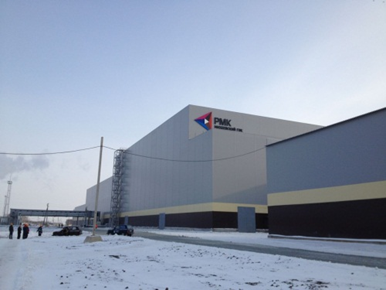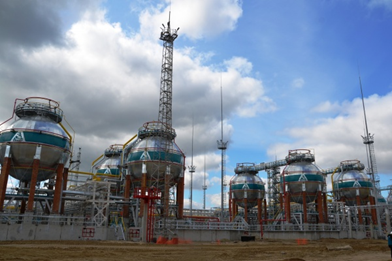What kind of new plants were launched in Russia in 2013?
The largest construction of the late seven years in Sochi is well-known. But except Olympic objects there are new plants and enterprises that are launched annually in Russia. Thus, during 2013 more than 200 projects on creation of new plants were put into operation within Russia. 134 of them were started from the scratch. At the same time, the investments of RUR 1 billion for each were required in order to launch 107 objects and for 51 international investments were invited.

Figure 1. Tuapsinsky Oil Refinery
OJSC Oil Company Rosneft keeps investing in the modernization of industrial capacity. Thus, following the results of the previous year, the launch of the biggest in Russia oil refining unit in Tuapsinsky Oil Refinery became one of the most expensive projects. The total value of investments amounted to RUR 301 billion, RUR 208 billion of which have already been spent on modernization. Due to the fact that Tuapsinsky Oil Refinery is a city-forming enterprise, the launch of the first stage of the plant enabled to create nearly 400 new workplaces. In future, on completing of the construction, it is expected to increase the number of workplaces up to 700. According to the officials of the Krasnodar Krai, launch of the upgraded Tuapsinsky Oil Refinery will increase the Gross Regional Product (GRP) of the Krai on RUR 135 billion.

Figure 2. Mikheyevsky mining and concentration complex
On December 17, 2013 Mikheyevsky mining and concentration complex was launched in the Chelyabinsk region. This complex is one of the largest investment projects of the Russian copper company at the moment. The total allocated budget of the project comes out RUR 27 billion. The Mikheyevsky mining and concentration complex is for today the first large-scale project of the mining and concentration complex construction from the scratch within Russia and the former Soviet Union. Subsequently, it is planned to integrate the complex into production chain of the full range of the Russian copper company. This project enables to create more than 500 new workplaces and the target amount of tax liabilities during implementation of the project accounts for RUR 28 billion.

Figure 3. LLC Tobolsk-Polimer
The launch of the polypropylene production complex in the Tyumen Region – LLC Tobolsk-Polimer became one of the largest projects in Russian petrochemical industry. LLC Tobolsk-Polimer is a subsidiary of gas processing and petrochemical company SIBUR. The total investment volume of the project amounted to RUR 60 billion. Nearly 500 new workplaces were created on the basis of the new enterprise. It is hard to overestimate the value of this company, as it makes possible for Russia to become the exporter instead of the importer of the polypropylene. Polypropylene is the third consumable plastic in the world that is used in different industries from automobile manufacturing to hollowware industry and package printing.

Figure 4. The Big Koryazhma
The Russian paper-pulp industry has interesting investment projects, too. First of all, it is important to note 2 challenging branch modernization projects and launch of new manufacturing lines of the Ilim group – the Big Bratsk and the Big Koryazhma. The total amount of the Big Bratsk project investments accounted for more than RUR 25 billion. According to experts, introduction of the upgraded capacity enables to increase the overall production in Bratsk up to 1 billion ton per year. At the same time the new line in Bratsk will become the biggest coniferous line in the world. Therefore it will be possible to increase export of high-quality products to China. Production of the white softwood pulp should become the priority production. It is one of the most expensive kinds of pulp used as a raw material for manufacture of high-quality paper products. The cost of the Big Koryazhma project amounted to RUR 8,6 billion. Within the framework of this project the company Ilim was the first in Russia to manufacture chalk paper. The project created more than 350 new workplaces.

Figure 5. Serpukhov plant for elevator construction
Serpukhov plant for elevator construction was launched in the Moscow Region. It is the first experience of construction of such a large plant from the scratch. According to experts, the capacity of the new plant enables to move to the fore on the market during 2 years. Moreover, the need for elevators in Russia amounts to 35 thousands per year and demand for the business class elevators shows annual surplus of 16%. The volume of the project investments accounts for RUR 3 billion. Besides, the unique testing tower 33 floors high was built within the framework of the project. The tower is one in whole Europe. The launch of the plant enables to create nearly 800 new highly qualified workplaces.
It was many times mentioned that for economic growth there should be moving from extensive economy development path, concentrated in materials sector, to intensive. Due to this, it is important to develop a knowledge-intensive industry that requires investment infusions. In this regard the variety of plants, launched last year cannot but please. The launch of new plants not only generates employment, but also encourages the growth of competitive ability of domestic products.
The unified tax for the small business: fact or fiction?
On the recent press conference Mikhail Orlov, the chairman of the board of the State Duma Committee on Budget and Taxes, has stated that within the simplification of the small business tax administration policy, the State Duma drafts a bill that is going to introduce the one stop-shop principle for fiscal charges.
The core of the initiative comes down to the fact that all the liabilities of the taxpayer to the state will be united into one payment, which entrepreneur will pay once a year or at other intervals.
Besides, one more important aspect of the reform is being studied. The board of Treasury, not the company itself, is going to distribute the unified payment into different level budgets and into non-budgetary funds. At the moment it is making incursions upon company’s labor hours.
The governmental authorities more often began to speak about the support of the small business, after it became clear than the country’s economy has sunk into stagnation under well external business climate on export goods. Its share in the Russia’s GDP is still low enough, especially in comparison with developed countries. The increase of required insurance payments resulted in the fact that more than 500 thousand small firms were closed down in a short time. Such controversial steps led to boomerang effect – the total tax base has decreased. The offered bill should to some extent compensate the loss.
The unified tax principle is instinctively clear and can be easily implemented in practice both for the payer and for fiscal authorities. The question “what kind of total load will it be for the entrepreneur?” remains undetermined. In fact, it is hard to understand the real effective rate of all the payments, when there are a lot of taxes and the payments are delivered at different times. On the other hand, the high interest amount of the general tax may exert negative psychological effect on the people, starting their business for the first time.